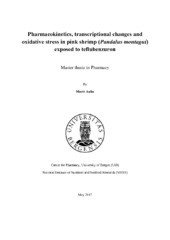Pharmacokinetics, transcriptional changes and oxidative stress in pink shrimp (Pandalus montagui) exposed to teflubenzuron
Master thesis
Permanent lenke
https://hdl.handle.net/1956/16153Utgivelsesdato
2017-06-28Metadata
Vis full innførselSamlinger
Sammendrag
In the recent years, infestation with salmon lice has become a major problem in salmonid farms, and has resulted in great economic losses and reduced welfare for farmed salmonids. To enhance the salmon lice combat, there has been an increased use of antiparasitic drugs in salmonid farms, raising concerns about the impact of these chemicals in the environment. In this study, an experiment with the non-target species pink shrimp (Pandalus montagui) was carried out to evaluate the effects of the antiparasitic drug teflubenzuron to crustacean living close to the farms. The pink shrimps (14.0±1.2 mm carapax length) were fed two times weekly for 46 days, with two doses of teflubenzuron. The two doses, termed low dose and high dose contained 0.1% and 1% of a normal fish therapy dose, respectively. At the end of the feeding experiment, surviving shrimps were examined for morphological changes, like speckled eyes and deformities, before tissue from the whole shrimp were analysed by LC-MS/MS to measure accumulated teflubenzuron in the shrimps. Gene-expression analyses was performed to study the effect of teflubenzuron exposure at the transcriptional level, in addition to colorimetric analyses to monitor changes in protein carbonyl concentration and malondialdehyde levels, both indicating oxidative stress. Overall, the studies showed a high mortality rate (20%) among the shrimps exposed to high dose of teflubenzuron, whereas the small dose yield no mortality. Deformities like stiff and crocked legs were seen in both group receiving teflubenzuron. In the pharmacokinetic analyses, the mean concentration of teflubenzuron was significantly higher (10.5-fold) in the high dose group (70.39 ng/g w.w) compared to the low dose group (6.65 ng/g w.w). However, concentrations of teflubenzuron above LOQ (<0.2 ng/g w.w) were obtained in the control groups, suggesting that there might have been a contamination during the experiment. For this reason, extra shrimps from the same catch were added as an additional control to all sample analyses in this work, and all results are presented with initial controls and additional controls. The transcriptional data indicated that exposure of teflubenzuron at the studied concentrations could have a weak effect on antioxidative defence and detoxification mechanisms in shrimps. Moreover, correlation analyses suggested that teflubenzuron might have an impact on growth in shrimps. However, due to concentrations of teflubenzuron above LOQ in the controls, the results from the molecular part of this work are non-conclusive.
